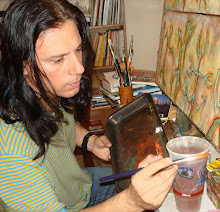 Margo Thoma, Eight Modern Co-Director and Carlos Pérez Vidal at the Opening Reception of Time as Metaphor.
Margo Thoma, Eight Modern Co-Director and Carlos Pérez Vidal at the Opening Reception of Time as Metaphor.Carlos Pérez Vidal, current artwork addressing the issues of personal identity, cultural memory, and art-historical stereotyping, communicates his sociopolitical observations in a visual language that surreally compounds parody, visual poetry, and uncanny elements. The artist is known for creating confrontational dialogues between diverse iconographies and the specific framework of the Spanish Colonial altar. Drawing upon the cultural diversity of the Americas, Time as Metaphor reveals unexpected connections between seemingly disparate religious, political, and art-historical icons.
 New Mexico Artist, Carlos and New Mexico Friend.
New Mexico Artist, Carlos and New Mexico Friend. Carlos Pérez Vidal, during the Live Video Performance and Installation.
Carlos Pérez Vidal, during the Live Video Performance and Installation.

 Time is Over, Video Performance and Installation.
Time is Over, Video Performance and Installation. 


 Twenty-seven Chosen and One Errant, Mixed Media, Installation.
Twenty-seven Chosen and One Errant, Mixed Media, Installation.  Dialéctica de la Fidelidad, Mixed Media, Installation.
Dialéctica de la Fidelidad, Mixed Media, Installation.


 Carl Thoma, Eight Modern Insvestor, and Art Collector.
Carl Thoma, Eight Modern Insvestor, and Art Collector.
 Live Video Performance and Installation, Eight Modern, Santa Fe, N.M.
Live Video Performance and Installation, Eight Modern, Santa Fe, N.M. Carlos during the "Smoking the History" (To the outstanding Generation of 1980), Live Video Performance at Eight Modern.
Carlos during the "Smoking the History" (To the outstanding Generation of 1980), Live Video Performance at Eight Modern.Time as Metaphor signifies Eight Modern’s continued commitment to premiering works by internationally acclaimed artists who have never before been represented in Santa Fe.









 Carlos Pérez Vidal at around the age of six, his best friend’s father, a well-known ceramicist, remarked on Carlos’ talent to his parents, and urged then to send him to art school. “Every single day when I finished school, I would do two things: play baseball and do artwork – sculpture, drawing, painting and ceramic, together with my best friend Oscar”. he recalls. His parents support him with art education. Carlos was nurtured by the same art teacher through the age of 10, then passed the test to move to the next level of elementary art school, and later the next in the famous San Alejandro Academy of Visual Art, and then in the National Art School of Havana. Eventually he gained admission to the prestigious Superior Art Institute of Havana. By the time he graduated in 1989, he was already very active in the Cuban Renaissance, the avant-garde movement in Cuba. “ It was a great new Cuban art revolution,” say Pérez Vidal. He was founder member of Group La Campana, involved with conceptual and performance art. “ Our outstanding Generation were trying to democratize the culture,” he say. By the lately 1980s and the early 1990s, censorship of artists had driven many of the most intellectual among then to emigrate to Europe, Canada, Mexico and the United States.
Carlos Pérez Vidal at around the age of six, his best friend’s father, a well-known ceramicist, remarked on Carlos’ talent to his parents, and urged then to send him to art school. “Every single day when I finished school, I would do two things: play baseball and do artwork – sculpture, drawing, painting and ceramic, together with my best friend Oscar”. he recalls. His parents support him with art education. Carlos was nurtured by the same art teacher through the age of 10, then passed the test to move to the next level of elementary art school, and later the next in the famous San Alejandro Academy of Visual Art, and then in the National Art School of Havana. Eventually he gained admission to the prestigious Superior Art Institute of Havana. By the time he graduated in 1989, he was already very active in the Cuban Renaissance, the avant-garde movement in Cuba. “ It was a great new Cuban art revolution,” say Pérez Vidal. He was founder member of Group La Campana, involved with conceptual and performance art. “ Our outstanding Generation were trying to democratize the culture,” he say. By the lately 1980s and the early 1990s, censorship of artists had driven many of the most intellectual among then to emigrate to Europe, Canada, Mexico and the United States.




























